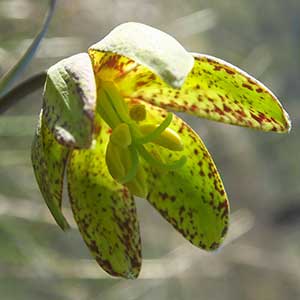Fritillaria glauca
Fritillaria eastwoodiae
Siskiyou fritillaria, Siskiyou fritillary, Siskiyou missionbells
Butte County fritillary
large 3–9; small 1–9.
large 2–5; small 10–60.
0.8–2 dm.
2–8 dm.
2–4, alternate, 3.5–9 cm;
blade lanceolate-oblong, sickle-shaped, glaucous.
in 1–2 whorls of 3–5 leaves per node proximally, alternate distally, 5–10 cm, usually shorter than inflorescence;
blade linear to narrowly lanceolate, ± glaucous;
distal leaves usually ± equaling proximalmost leaf.
nodding;
tepals purplish or greenish marked with yellow, lanceolate-oblong, 1.5–2.5 cm, apex not recurved;
nectaries green with maroon dots, broadly lanceolate, less than 1/2 tepal length;
style obviously branched for 1/2 its length, branches longer than 1.5 mm.
nodding;
tepals pale greenish yellow to red, narrowly elliptic, 1–1.7 cm, apex usually flared to slightly recurved;
nectaries green, gold, or yellow, lanceolate, less than 1/3 tepal length;
style obviously branched for less than 1/2 its length, branches barely recurved, longer than 1.5 mm.
broadly winged.
angled.
= 24.
= 24, 34, 36.
Fritillaria glauca
Fritillaria eastwoodiae
This species is highly variable and shows evidence of either being of hybrid origin between Fritillaria recurva and F. micrantha, or, if it is of separate origin, appearing to hybridize easily with those two species. In the northern part of its range, F. eastwoodiae intergrades with F. recurva, whereas in the southern part of its range it intergrades with F. micrantha. Occasional individuals throughout the range display traits of both F. recurva and F. micrantha.
(Discussion copyrighted by Flora of North America; reprinted with permission.)


